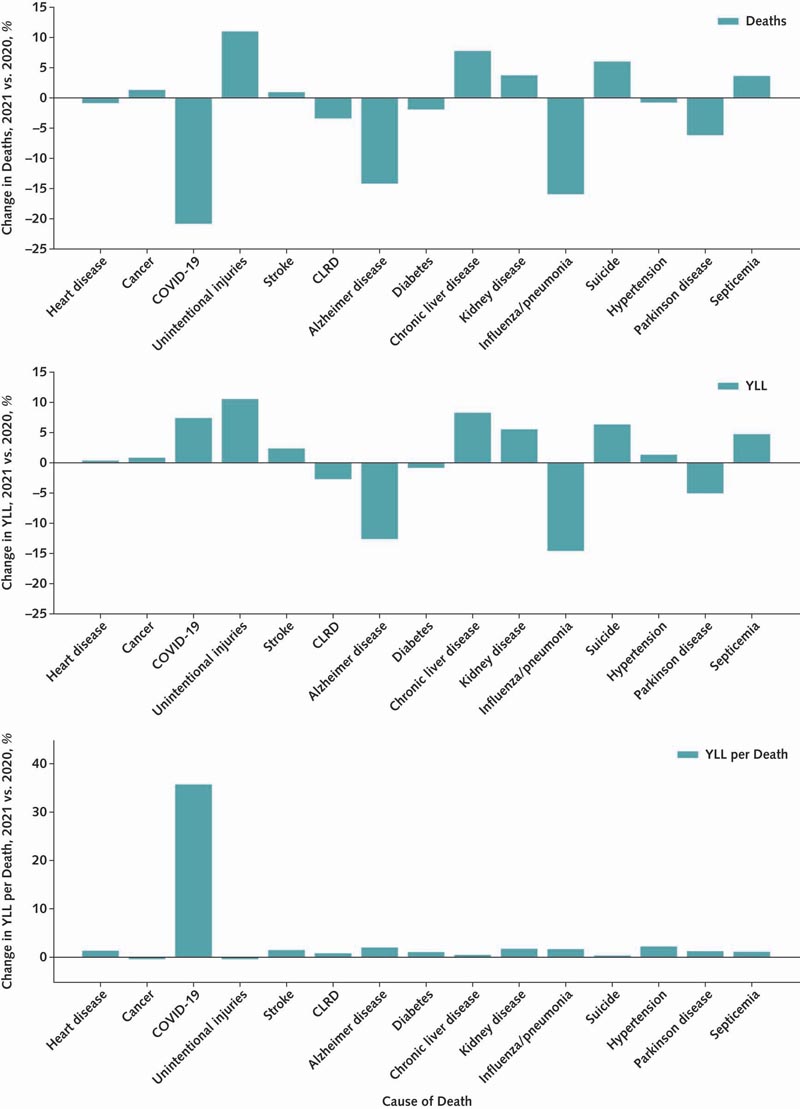Background: During March 2020 to September 2022, more than 1 million COVID-19-related deaths occurred in the United States (1). As described by Shiels and colleagues (2), COVID-19 deaths between March and December 2020 and January and October 2021 were similar. However, COVID-19-related deaths increased among younger people and decreased among older adults in 2021 versus 2020 (2), reflecting excess premature mortality from COVID-19. Aim: We struggled to quantify this downward age shift in COVID-19-related deaths, which required an age-weighted metric. Unlike the mortality metric, the years of life lost (YLL) measure (3) provides an indicator of premature mortality based on the estimated number of years a person would have lived if they had not died prematurely. Therefore, we sought to estimate YLLs associated with leading causes of death in the US over paired 10-month intervals in 2020 and 2021. Findings Since March 2020, COVID-19-related deaths have claimed more than a million lives in the U.S. alone. In the early phases of the pandemic, most deaths occurred among older adults, but in 2021, deaths in younger people increased while deaths in older people decreased. A new study by two researchers at Brigham and Women’s Hospital , a founding member of the Mass General Brigham healthcare system , addresses this unexpected shift in COVID-19 mortality among relatively younger Americans and finds an increase in years of life lost due to COVID-19. |

Changes in the main causes of death and associated YLLs, from March to December in 2020 and 2021. For all panels, the results are compared from March to December 2021 with the reference interval from March to December 2020. Deaths from Unintentional injuries include motor vehicle transportation accidents, unintentional drug overdoses and alcohol-related deaths, and other unintentional injuries that result in deaths. CLRD = chronic lower respiratory disease; YLL = years of life lost. Upper part. Changes in the main causes of death. Half. Changes in AVP. Below. Changes in YLL due to death. Bars indicate the percentage difference between the study intervals for each outcome.
Taking a closer look at this trend brings to light important questions about the COVID-19 pandemic, mortality trends, and public health. Their results are published in Annals of Internal Medicine .
Comments
Earlier in the COVID-19 pandemic, age and pre-existing conditions played an important role in the development of public health advice. But by early 2021, the COVID-19 landscape had completely changed; Vaccines became available, treatments advanced, and people’s behaviors changed. While 2020 COVID-19 mortality rates were high among older adults, those older adults exhibited a relatively higher vaccination rate and adhered more strictly to non-pharmaceutical interventions during 2021. Such systemic and behavioral changes in response to COVID-19 affected mortality rates and determined which ages, in which years, were most at risk.
"There were a lot of changes between the first and second years of the COVID-19 pandemic," said corresponding author Mark Czeisler, PhD, a medical student at Harvard Medical School, organizer of the COPE Initiative, and member of the Department of Psychiatry. of Brigham. “Researchers have sought to understand the impacts of advances in COVID-19 treatments, immunity due to vaccines and infections, and scientific knowledge of the COVID-19 virus and its emerging variants. But before our study, less attention was paid to quantifying premature mortality associated with COVID-19 in 2021 compared to 2020."
Between March 2020 and October 2021, COVID-19 remained one of the top five causes of death among American adults. However, their specific rank within the top five changed by age, demonstrating a higher proportion of young people dying prematurely from COVID-19 in 2021. The researchers quantified this downward age shift in COVID-19 deaths. 19, using Years of Life Lost (YLL) instead of mortality. The team collected relevant data on COVID-19 deaths in two time intervals, from March to December 2020 and 2021, using the CDC’s Wide Range Online Data for Epidemiologic Research (WONDER) database. The 2017 World Population Prospects and the World Health Organization’s Global Health Estimate were then used to estimate average life expectancy.
Using these resources, the team calculated the percentage of COVID-19 deaths and YLL per death. Despite 20.8 percent fewer COVID-19 deaths in 2021 compared to 2020, YLLs due to COVID-19 increased by 7.4 percent . As the age distribution of deaths moved downward, the average age of COVID-19 deaths decreased from 78 years in 2020 to 69 years in 2021. The researchers found that the YLLs per COVID-19 death increased by 35.7 percent; most of the other 15 leading causes of death remained stable across time intervals, and the YLLs per death from these non-COVID-19 causes did not change more than 2.2 percent.
Two secondary findings were also observed: Alzheimer’s and Parkinson’s deaths and YLLs decreased , possibly due to COVID-19 disease misattribution and reduced medical access early in the pandemic; and the number of deaths and YLLs due to unintentional injuries increased significantly, which the researchers did not directly explore in this analysis but attributed to the acceleration of the opioid epidemic and associated drug overdose deaths.
The study was limited by two main factors: 2021 death records are not finalized until 12 months after the autopsy; and individuals were not fully characterized by comorbidities, vaccination status, or any other determinants. Researchers are hopeful that their insights will inform a broader story of mortality and loss during the COVID-19 pandemic, while inspiring further research into the factors contributing to this trend.
“A shift in COVID-19 mortality to relatively younger people in the second year of the pandemic contributed to a notable increase in premature mortality from this increasingly preventable death,” Czeisler said. “Understanding the factors contributing to this age shift is critical as we continue to develop our knowledge of the COVID-19 pandemic.”
Discussion:
In the United States, 20.8% more COVID-19-related deaths were reported in the first 10 months of the pandemic compared to a matching seasonal range in the second year of the pandemic. Despite this, 7.4% more years of life were lost in the second year of the pandemic during that interval due to a 35.7% increase in YLLs due to COVID-19 death. Additional research should determine the extent to which this downward age shift in COVID-19 mortality is attributable to high COVID-19 mortality rates in the early pandemic among older adults (e.g., involving nursing homes). elderly and long-term care facilities), relatively higher vaccine coverage and compliance with non-pharmaceutical interventions among older versus younger adults later in the pandemic, age-related risk differences associated with coronavirus variant viruses or other mechanisms . Understanding this shift in COVID-19 mortality dynamics could inform prevention and treatment approaches, public policy development, and community measures to minimize the future effects of COVID-19.
YLL analysis reveals additional shifts among leading causes of death in the US. YLLs and deaths from Alzheimer’s and Parkinson’s diseases declined , perhaps due to increased incidence of each during the early pandemic due to misattribution of COVID-19 deaths when there was limited testing and a considerable amount of lost medical care related to COVID-19. In contrast, YLLs and unintentional injury deaths increased sharply, due in part to record drug overdose deaths, up 15% (nearly 14,000 deaths) in 2021 compared to 2020.
Strengths of this analysis include the use of national mortality data and age-specific projected standard life expectancies to estimate YLLs. Limitations include provisional 2021 deaths, which are subject to reporting delays. Importantly, the YLL metric compares a person’s life expectancy to their age at the time of their death and should not be used as a measure of a person’s potential contributions to society.
In conclusion , a shift in COVID-19 mortality to relatively younger people in the second year of the pandemic contributed to notably elevated YLLs for this increasingly preventable cause of death.
















